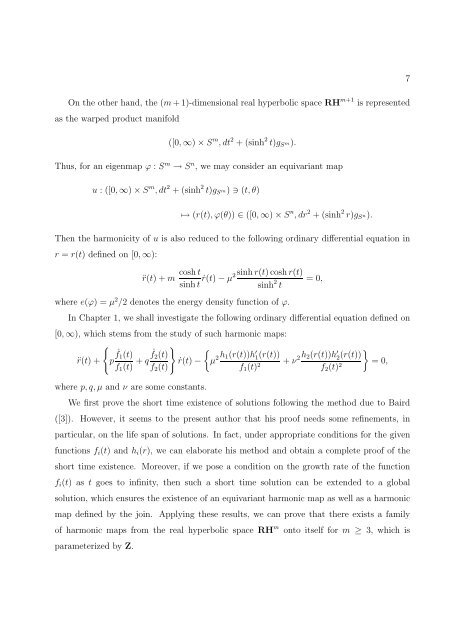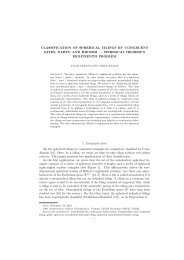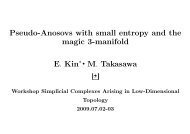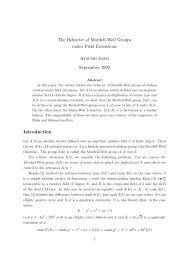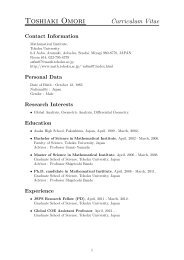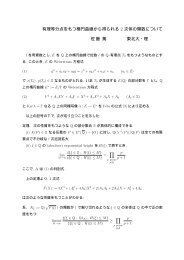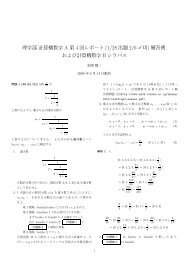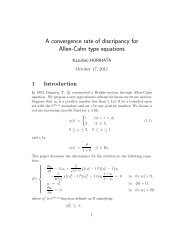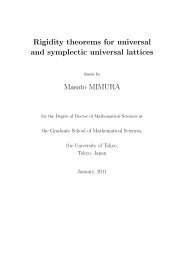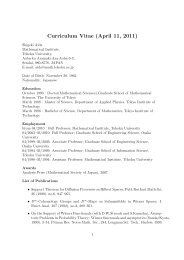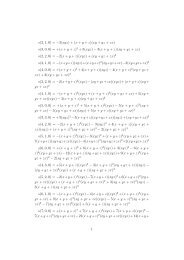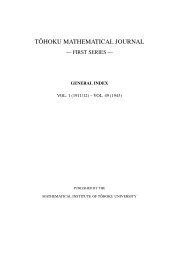Constructions of harmonic maps between Hadamard manifolds
Constructions of harmonic maps between Hadamard manifolds
Constructions of harmonic maps between Hadamard manifolds
Create successful ePaper yourself
Turn your PDF publications into a flip-book with our unique Google optimized e-Paper software.
On the other hand, the (m + 1)-dimensional real hyperbolic space RH m+1 is represented<br />
as the warped product manifold<br />
([0, ∞) × S m ,dt 2 + (sinh 2 t)g S m).<br />
Thus, for an eigenmap ϕ : S m → S n , we may consider an equivariant map<br />
u : ([0, ∞) × S m ,dt 2 + (sinh 2 t)g S m) ∋ (t, θ)<br />
↦→ (r(t),ϕ(θ)) ∈ ([0, ∞) × S n ,dr 2 + (sinh 2 r)g S n).<br />
Then the <strong>harmonic</strong>ity <strong>of</strong> u is also reduced to the following ordinary differential equation in<br />
r = r(t) defined on [0, ∞):<br />
¨r(t)+m cosh t sinh r(t) cosh r(t)<br />
ṙ(t) − µ2<br />
sinh t sinh 2 t<br />
where e(ϕ) =µ 2 /2 denotes the energy density function <strong>of</strong> ϕ.<br />
In Chapter 1, we shall investigate the following ordinary differential equation defined on<br />
[0, ∞), which stems from the study <strong>of</strong> such <strong>harmonic</strong> <strong>maps</strong>:<br />
{<br />
f<br />
¨r(t)+ p ˙ 1 (t)<br />
f 1 (t) + q f ˙ } {<br />
2 (t)<br />
ṙ(t) − µ 2 h 1(r(t))h ′ 1(r(t))<br />
+ ν 2 h }<br />
2(r(t))h ′ 2(r(t))<br />
=0,<br />
f 2 (t)<br />
f 1 (t) 2<br />
f 2 (t) 2<br />
where p, q, µ and ν are some constants.<br />
We first prove the short time existence <strong>of</strong> solutions following the method due to Baird<br />
([3]). However, it seems to the present author that his pro<strong>of</strong> needs some refinements, in<br />
particular, on the life span <strong>of</strong> solutions. In fact, under appropriate conditions for the given<br />
functions f i (t) and h i (r), we can elaborate his method and obtain a complete pro<strong>of</strong> <strong>of</strong> the<br />
short time existence. Moreover, if we pose a condition on the growth rate <strong>of</strong> the function<br />
f i (t) ast goes to infinity, then such a short time solution can be extended to a global<br />
solution, which ensures the existence <strong>of</strong> an equivariant <strong>harmonic</strong> map as well as a <strong>harmonic</strong><br />
map defined by the join. Applying these results, we can prove that there exists a family<br />
<strong>of</strong> <strong>harmonic</strong> <strong>maps</strong> from the real hyperbolic space RH m onto itself for m ≥ 3, which is<br />
parameterized by Z.<br />
=0,<br />
7


